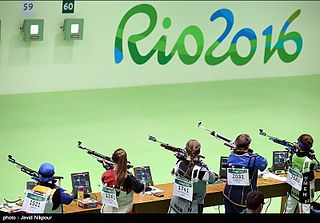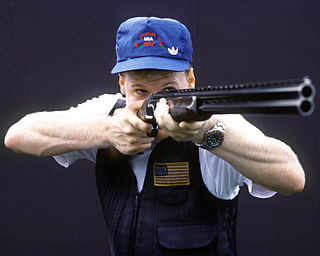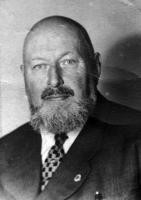
The International Shooting Sport Federation recognizes several shooting events, some of which have Olympic status. They are divided into four disciplines: rifle, pistol, shotgun and running target.

Trap shooting is one of the three major disciplines of competitive clay pigeon shooting. The other disciplines are skeet shooting and sporting clays.

Olympic trap is a shooting sports discipline contested at the Olympic Games and sanctioned by the International Shooting Sport Federation. Usually referred to simply as "trap", the discipline is also known in the United States as international trap, bunker trap, trench or international clay pigeon. It is considered more difficult than most other trap versions in that the distance to the targets and the speed with which they are thrown are both greater.

The Russian Empire (Russia) competed at the 1912 Summer Olympics in Stockholm, Sweden. 159 competitors took part in 62 events in 15 sports.

Germany competed at the 1912 Summer Olympics in Stockholm, Sweden. 185 competitors, 180 men and 5 women, took part in 69 events in 14 sports. Due to the political fallout from World War I, this was the country's last appearance until 1928.

The men's 300 metre team free rifle was a shooting sports event held as part of the Shooting at the 1912 Summer Olympics programme. It was the third appearance of the event. The competition was held on Thursday, 4 July 1912. Forty-two sport shooters from seven nations competed. The event was won by Sweden, the nation's first victory in the event, improving on a silver-medal performance in 1908. Defending champions Norway reached the podium for the third consecutive time, taking silver this time. Denmark earned its first medal in the men's 300 metre team free rifle with bronze.
The men's 50 metre team small-bore rifle was a shooting sports event held as part of the Shooting at the 1912 Summer Olympics programme. It was the second appearance of the event, with a mixed-distance team small-bore rifle event having been held in 1908. A standing 50 metre team small-bore event would be held in 1920. The competition was held on Wednesday, 3 July 1912.

The men's 50 metre team pistol was a shooting sports event held as part of the shooting at the 1912 Summer Olympics programme. It was the third appearance of the event, which had also been held in 1900 and 1908. The competition was held on Tuesday, 2 July 1912. Twenty sport shooters from five nations competed. The event was won by the United States, successfully defending its Olympic title. The American team included John Dietz, a veteran of the 1908 Games, making him the first to win multiple medals in the event. Silver went to Sweden. Great Britain repeated as bronze medalists.
The men's trap, team was a shooting sports event held as part of the shooting at the 1912 Summer Olympics programme. It was the second appearance of the event, which had been introduced in 1908. The competition was held from Saturday, 29 June 1912 to Monday, 1 July 1912.
The men's 50 metre rifle from the prone position was a shooting sports event held as part of the Shooting at the 1912 Summer Olympics programme. It was the first appearance of the event. The competition was held on Thursday, 4 July 1912.

The men's 300 m rifle three positions was a shooting sports event held as part of the shooting at the 1912 Summer Olympics programme. It was the third appearance of the event, which had been introduced in 1900. The competition was held on Tuesday, 2 July 1912. Eighty-four sport shooters from nine nations competed. The event was won by Paul Colas of France, the nation's first medal in the event. Denmark took the silver and bronze medals, as Lars Jørgen Madsen finished second and Niels Larsen placed third.

The men's individual competition with revolver and pistol, distance 50 metres was a shooting sports event held as part of the shooting at the 1912 Summer Olympics programme. It was the fourth appearance of the event, which was the only one to have been featured at every edition of the Games to that point. The competition was held on Monday, 1 July 1912. Fifty-four sport shooters from twelve nations competed. Nations were limited to 12 shooters each. The event was won by Alfred Lane of the United States, completing a double for him with the rapid fire pistol event. It was the United States' second victory in the event. Another American, Peter Dolfen, finished second. Charles Stewart of Great Britain took the bronze medal, the nation's first in the free pistol.

The men's 30 metre dueling pistol was a shooting sports pistol event held as part of the 1912 Summer Olympics shooting programme. It was later standardized by the ISSF to the men's 25 metre rapid fire pistol. It was the third appearance of the event, as it had not been featured at the 1908 Games. The competition was held on Saturday, 29 June 1912. Forty-two sport shooters from ten nations competed. Nations were limited to 12 shooters each. The event was won by Alfred Lane of the United States, in the nation's debut. Sweden, also making its debut, earned the silver and bronze medals.

The men's trap was a shooting sports event held as part of the Shooting at the 1924 Summer Olympics programme. It was the fifth appearance of the event. The competition was held from 8 to 10 July 1924 at the shooting ranges at Issy-les-Moulineaux. 44 shooters from 14 nations competed. A maximum of four competitors per nation were allowed. The event was won by Gyula Halasy of Hungary, a victory in the nation's debut in the event. Silver went to Konrad Huber of Finland, that nation's first medal in the men's trap. The United States, which had earned gold in 1912 and 1920, took bronze this year with Frank Hughes on the podium.

The men's individual competition with revolver and pistol was a shooting sports event held as part of the Shooting at the 1920 Summer Olympics programme. It was the fifth appearance of such an event at different distances. The competition was held on 2 August 1920. 31 shooters from 8 nations competed. The event was won by Karl Frederick of the United States, the nation's second consecutive and third overall victory in the event. Defending champion Alfred Lane took bronze, the first man to win multiple medals in the event. Brazil's Afrânio da Costa finished between the two Americans, taking silver.

The men's trap was a shooting sports event held as part of the Shooting at the 1920 Summer Olympics programme. It was the fourth appearance of the event. The competition was held on 23 and 24 July 1920 and 18 shooters from seven nations competed. The United States swept the podium ; it was the second sweep in the men's trap. Mark Arie took the gold medal, the second consecutive victory by an American. Frank Troeh earned silver, while Frank Wright finished with bronze. Arie also received Lord Westbury's Cup, a challenge prize previously awarded in 1908 and 1912 to the winners of those years' men's trap competitions.

Men's trap shooting was one of the fifteen shooting events at the 1996 Summer Olympics. It was held on 20 and 21 July 1996 at the Wolf Creek Shooting Complex. There were 58 competitors from 41 nations, with each nation having up to three shooters. Michael Diamond of Australia won, setting two new Olympic records, ahead of two Americans. After the regular 150 targets, it took a marathon shoot-off to separate the silver and bronze medalists; after both shooters had hit 27 straight targets, Josh Lakatos hit his 28th while Lance Bade missed. It was the first medal in the men's trap for Australia; the United States had most recently been on the podium in the event in 1984.

The trap competition at the 1972 Summer Olympics was an open-gender event held from 27 to 29 August 1972 at Schießanlage. There were 57 competitors from 34 nations, with each nation limited to two shooters. The 1970 and 1971 world champion and co-holder of the world record Michel Carrega of France finished a surprise second to Angelo Scalzone of Italy, who broke the world record with a near perfect performance of 199 out of 200. Bronze went to Silvano Basagni, also of Italy. Scalzone's victory was Italy's third gold medal in the last five Games; Carrega's medal was France's first medal in the trap since the nation swept the medals in 1900.

The trap was a shooting sports event held as part of the Shooting at the 1968 Summer Olympics programme. The competition was held on 18 and 19 October 1968 at the shooting ranges in Mexico City. 55 shooters from 34 nations competed. For the first time, the event was open to women as well as men. Nations were limited to two shooters each. The event was won by Bob Braithwaite of Great Britain, the nation's first victory in the event and first medal of any color in the trap since 1908. Silver went to Thomas Garrigus of the United States. Kurt Czekalla of East Germany took bronze; it was the first medal in the event for East Germany as a separate nation, and the first medal for any German trap shooter since 1912.

The men's trap was a shooting sports event held as part of the Shooting at the 1960 Summer Olympics programme. The competition was held from 15 to 17 October 1964 at the Tokorozawa Clay Pigeon Shooting Range in Tokorozawa, Saitama. 51 shooters from 28 nations competed. Each nation could send up to two shooters. The event was won by Ennio Mattarelli of Italy, the nation's second victory in three Games in the event. Pāvels Seničevs of the Soviet Union took silver. William Morris earned the United States' first medal in the trap since 1924 with his bronze. Seničevs and Morris defeated Galliano Rossini of Italy in a three-way shoot-off for second; Rossini thus just missed earning a third medal in the trap. Defending champion Ion Dumitrescu of Romania finished fifth.












